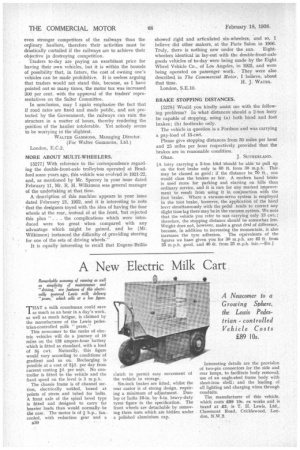A New Electric Milk Cart
Page 40

If you've noticed an error in this article please click here to report it so we can fix it.
THAT a milk roundsman could save as much as an hour in a day's work, as well as much fatigue, is claimed by the manufacturer of the Lewis pedestrian-controlled milk "pram."
This newcomer to the ranks of electric vehicles will do a journey of 10 miles on the 128 ampere-hour battery which is fitted as standard, with a load of 34 cwt. Naturally, this figure would vary according to conditions of gradient and so on. Recharging is possible at a cost of 24d. per day from current costing id. per unit. No controller is fitted to the vehicle and the fixed speed on the level is 3 m.p.h.
The chassis frame is of channel section, electrically welded, boxed at points of stress and tubed for bolts. A front axle of the spiral bevel type is fitted and designed to carry far heavier loads than would normallybe the case. The motor is of / h.p., fancooled, with reduction gear and a
u30
clutch to permit easy movement of the vehicle in storage.
Six-inch brakes are fitted, whilst the rear castor is of strong design, requiring a minimum of adjustment. Dunlop or India 16-in. by 4-in, heavy-duty tyres figure in the specification. The front wheels are detachable by removing three nuts which are hidden under a polished aluminium cap. Interesting details are the provision of two-pin connectors for the side and rear lamps, to facilitate body removal; use of an angle-steel frame body with sheet-iron shell ; and the leading of all lighting and charging wires through conduits.
The, manufacturer of this vehicle, which costs £89 10s. ex works and is taxed at £2, is T. H. Lewis, Ltd., Claremont Road, Cricklewood, London, N.W.2.




















































































